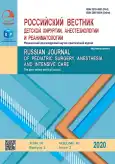Сравнительный анализ динамики длительности операции и гематологических показателей кровопотери после выполнения остеотомии подвздошной кости и ацетабулопластики при лечении детей с последствиями спинномозговых грыж
- Авторы: Иванов С.В.1, Кенис В.М.1
-
Учреждения:
- Федеральное государственное бюджетное учреждение «Национальный медицинский исследовательский центр детской травматологии и ортопедии имени Г.И. Турнера» Министерства здравоохранения Российской Федерации
- Выпуск: Том 10, № 2 (2020)
- Страницы: 137-143
- Раздел: Оригинальные исследования
- URL: https://journals.rcsi.science/2219-4061/article/view/122902
- DOI: https://doi.org/10.17816/psaic637
- ID: 122902
Цитировать
Полный текст
Аннотация
Введение. Спинномозговые грыжи относят к тяжелому пороку развития позвоночника и спинного мозга. Патология тазобедренного сустава у детей с последствиями спинномозговых грыж всегда представляла одну из трудных и актуальных задач детской ортопедии.
Цель исследования: провести сравнительный анализ длительности операций и некоторых гематологических показателей кровопотери после выполнения остеотомии подвздошной кости и ацетабулопластики при лечении детей с последствиями спинномозговых грыж при наличии подвывиха и вывиха бедра, для определения наиболее безопасного хирургического вмешательства.
Материалы и методы. За период с 2015 по 2019 г. в ФГБУ «НМИЦ детской травматологии и ортопедии им. Г.И. Турнера» Минздрава России проведено обследование и лечение 60 пациентов в возрасте 3–8 лет с последствиями спинномозговых грыж с подвывихом и вывихом бедра. Все пациенты были разделены на 2 группы по 30 пациентов в каждой, отличающиеся методикой выполнения вмешательства на тазовом компоненте сустава. Первая группа представлена пациентами, которым была выполнена остеотомия подвздошной кости (52 сустава), направленная на стабилизацию тазобедренного сустава, вторая группа — дети, которым выполняли другой вариант вмешательства на тазовом компоненте сустава — ацетабулопластика (55 суставов).
Результаты. Как показывает наше исследование, выполнение остеотомии подвздошной кости требовало достоверно большего времени, чем ацетабулопластика (р = 0,0088 (p < 0,05)). Кроме того, выполнение остеотомии подвздошной кости сопровождалось более выраженным снижением уровня как гемоглобина, так и количества эритроцитов в крови, чем при выполнении ацетабулопластики.
Заключение. Проведенное нами исследование показало, что остеотомия подвздошной кости требует большего времени для ее выполнения и сопровождается более выраженным снижением гемоглобина и эритроцитов крови, чем проведение ацетабулопластики, в результате чего можно сделать вывод о предпочтительности ацетабулопластики в тех случаях, когда предполагаемый клинический результат и необходимая степень коррекции сопоставимы.
Ключевые слова
Полный текст
Открыть статью на сайте журналаОб авторах
Станислав Вячеславович Иванов
Федеральное государственное бюджетное учреждение «Национальный медицинский исследовательский центр детской травматологии и ортопедии имени Г.И. Турнера» Министерства здравоохранения Российской Федерации
Автор, ответственный за переписку.
Email: ortostas@mail.ru
ORCID iD: 0000-0002-2187-3973
канд. мед. наук, руководитель отделения № 5 (отделение детского церебрального паралича и Центр Spina bifida)
Россия, Санкт-ПетербургВладимир Маркович Кенис
Федеральное государственное бюджетное учреждение «Национальный медицинский исследовательский центр детской травматологии и ортопедии имени Г.И. Турнера» Министерства здравоохранения Российской Федерации
Email: kenis@mail.ru
ORCID iD: 0000-0002-7651-8485
д-р мед. наук, доцент, заместитель директора по развитию и внешним связям
Россия, Санкт-ПетербургСписок литературы
- Sharrard WJW. The segmental innervation of the lower limb muscles in man. Ann R Coll Surg Engl. 1964;35:106-122.
- Баиндурашвили А.Г., Иванов С.В., Кенис В.М. Подвывих и вывих бедра у детей с последствиями спинномозговых грыж (обзор литературы) // Травматология и ортопедия России. — 2013. — № 4. — С. 97–102. [Baindurashvili AG, Ivanov SV, Kenis VM. Subluxation and dislocation of the hip in children with spina bifida (Review). Traumatology and Orthopedics of Russia. 2013;(4):97-102. (In Russ).]
- Баиндурашвили А.Г., Иванов С.В., Кенис В.М. Нейросегментарный уровень и его значение при лечении подвывиха и вывиха бедра у детей с последствиями спинномозговых грыж // Ортопедия, травматология и восстановительная хирургия детского возраста. — 2016. — Т. 4. — № 4. — С. 6–11. [Baindurashvili AG, Ivanov SV, Kenis VM. Clinical implications of the neurosegmental level of injury in the treatment of hip dislocation and subluxation in children with spina bifida. Pediatric Traumatology, Orthopaedics and Reconstructive Surgery. 2016;4(4):6-11. (In Russ.)]. DOI: https://doi.org/10.17816/ptors446-11.
- Иванов С.В., Кенис В.М., Икоева Г.А., Коченова Е.А. Использование роботизированной двигательной реабилитации в комплексном лечении подвывиха и вывиха бедра у детей с последствиями спинномозговой грыжи // Ортопедия, травматология и восстановительная хирургия детского возраста. — 2014. — Т. 2. — № 4. — С. 32–35. [Ivanov SV, Kenis VM, Ikoeva GA. Kotchenova E.A. The use of robotic rehabilitation in complex treatment of subluxation and dislocation of the hip in children with sequelae of spina bifida. Pediatric Traumatology, Orthopaedics and Reconstructive Surgery. 2014;2(4):32-35. (In Russ.)]. DOI: https://doi.org/10.17816/ptors2432-35.
- Thompson RM, Foley J, Dias L, Swaroop VT. Hip Status and Long-term Functional Outcomes in Spina Bifida. J Pediatr Orthopaed. 2019;39(3):E168-E172. DOI: http://doi.org/10.1097/bpo.0000000000001266
- Yildirim T, Gursu S, Bayhan İA, et al. Surgical treatment of hip instability in patients with lower lumbar level myelomeningocele: Is muscle transfer required? Clin. Orthop. Relat. Res. 2015;473(10):3254-3260. DOI: https://doi.org/10.1007/s11999-015-4316-8
- Erol B, Bezer M, Küçükdarmaz F, Güven O. [Surgical management of hip instabilities in children with spina bifida (In Turkish)]. Acta Orthop Traumatol Turc. 2005;39(1):16-22. DOI: https://doi.org/10.1007/978-88-470-0651-5_27
- Salter RB. Innominate osteotomy in the treatment of congenital dislocation and subluxation of the hip. J Bone Jt Surg. 1961;43-B(3):518-539. DOI: https://doi.org/10.1302/0301-620x.43b3.518.
- Pemberton PA. Osteotomy of the ilium with rotation of the acetabular roof for congenital dislocation of the hip. J Bone Jt Surg. 1958;40-A(5):724-725. DOI: https://doi.org/10.2106/00004623-196547010-00004.
- Иванов С.В., Баиндурашвили А.Г., Кенис В.М. Хирургическое лечение подвывиха и вывиха бедра у детей с последствиями спинномозговых грыж // Хирургия. Журнал им. Н.И. Пирогова. — 2017. — № 8. — С. 64-68. [Ivanov SV, Baindurashvili AG, Kenis VM. Surgical treatment of hip subluxation and luxation in children with spinal hernia consequences. Pirogov Russian Journal of Surgery 2017;(8):64-68. (In Russ.)] DOI: https://doi.org/10.17116//hirurgia2017864-68.
Дополнительные файлы











